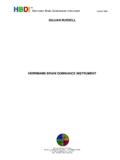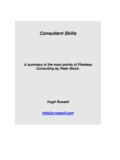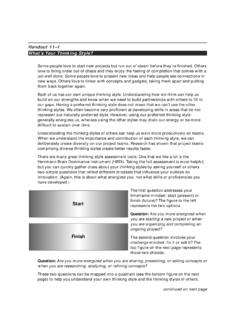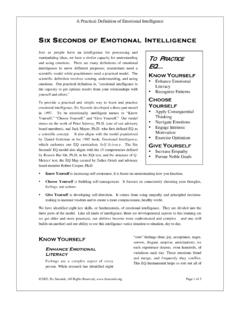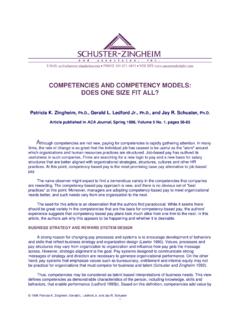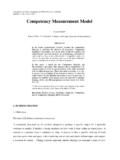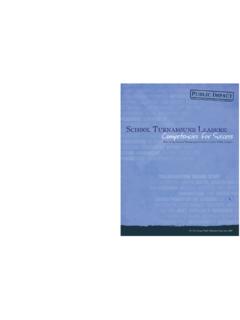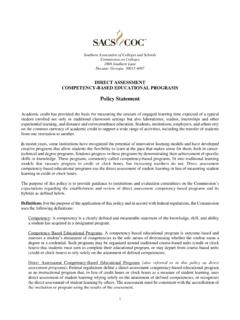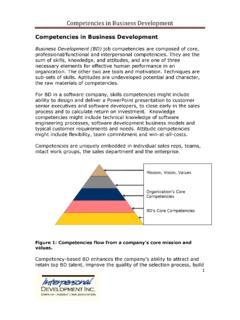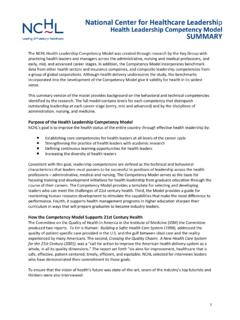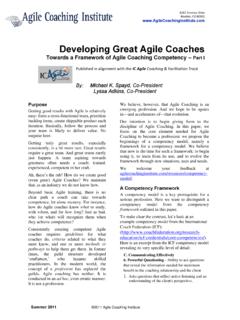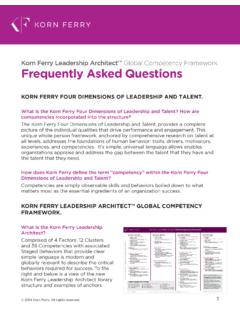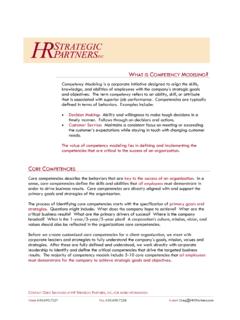Transcription of The Creation of the Emotional and Social …
1 The Creation of the Emotional and Social competency inventory (ESCI)Findings from a pilot study to achieve a higher psychometric standard with the E. Boyatzis, PhDProfessor in the Departments of Organizational Behavior and PsychologyCase Western Reserve UniversityDepartment of Human Resources, ESADES ummaryThe challengeThe Emotional Competence inventory (ECI-2) and the ECI-U (University Version) show acceptable validity and reliability in a variety of studies; in fact, levels that are relatively rare for tests available to most practitioners and consultants.
2 However, there is some criticism of our approach to conceptualizing and measuring EI in the professional research community. In some studies the competency scales do not appear valid as separate scales and the clusters do not differentiate themselves from each other. While this is of less concern to accredited users of the ECI, we decided to seek out a higher psychometric responseWe started by re-conceptualizing the tests, both the ECI-2 and the ECI-U, as measures of Social and Emotional intelligence competencies. We then reviewed every item (360 survey question) and competency scale, applying factor analyses and revising them as necessary to ensure that they identified specific behaviors and were understandable and concise.
3 This resulted in fewer competencies (12 instead of 18) and replaced the ECI-2 algorithm based on developmental levels with a measure based on consistency of behavior. The new instrument resulting from this work, the Emotional and Social competency inventory (ESCI), was piloted with a total of 116 participants and 1022 raters in the US and the UK. The findingsThe pilot study affirmed that the ESCI measures the behaviors that matter: those that contribute to effective performance. The psychometric standards achieved in the statistical analyses provided reassurance that the ESCI focuses on behaviors and the relationships between them that are observable, recognizable and distinct.
4 The removal of developmental levels delivers a behavioral model which can be applied more satisfactorily to a wide range of work contexts, job roles and levels. The feedback package behind the ESCI will show participants how others experience their behavior in terms of the consistency with which they demonstrate Emotional and Social intelligence competencies. It will help participants to appreciate their strengths, to recognize how consistently they do certain things, and to identify what they can do more of to be even more implicationsThe outcome of this work for the coaches and practitioners who are accredited to use the ECI is that there is now a choice of instruments.
5 While we are more than pleased with the psychometric goal that the ESCI has attained, and satisfied that the revisions to the items and feedback package ensure even wider applicability, we realize that there are many reasons why practitioners may want to continue to use the ECI-2, or to use both in different Actually, the WSOM and ESADE versions of the ECI-U also include the two major cognitive intelligence competencies , namely Systems Thinking and Pattern Recognition100100 What challenge were we facing?Since 1970, when the first competency study was conducted, we have established that competencies predict effectiveness in all sorts of management, leadership, and professional roles.
6 This has been shown in a thousand or more empirical studies, which have taken place in many countries. And yet the quest for academiclegitimacy and recognition ECI-2 and ECI-U show acceptable validity and reliability in a variety of studies. It measures what it s supposed to measure, and it measures it consistently. People doing research with it feel it complements the existing tests of Emotional intelligence. As a 360 test of competencies it is one of a number in the market, but the only one with some momentum to using the ECI-2 and ECI-U feel they significantly help their clients and students to examine their Emotional , Social , and cognitive competencies and to develop them.
7 They offer a number of distinctive features that coaches appreciate and value, like the developmental levels and feedback format. Through the efforts of colleagues at the Hay Group we have run many research projects using the ECI and ECI-U worldwide, and have built an increasing worldwide network of accredited ECI users. This has been good for the field, and has helped many people to appreciate and develop their strengths and does the ECI pose this challenge?Part of this stems from a conceptual problem that we imposed on the 360 instrument.
8 When we use behavioral sources, like comprehensive Behavioral Event Interviews (BEIs) or videotaped simulations, we derive alternate manifestations of the underlying competency . But when we move to a 360 test, we are asking untrained informants not trained coders to assess an individual and his or her behavior. And when informants are responding they need more guidance. We realized we could offer this guidance by integrating the intent behind a behavior into the wording of each item in the ESCI and big is the challenge?It is worth noting that the sound levels of validity ( the instrument measures what it is designed to measure) that we have achieved with the ECI-2 and ECI-U are relatively rare for tests available to most practitioners and consultants.
9 Most of the tests currently sold do not have this type of analytic back up. Of course, the tests used primarily in research are a different story. In the EI arena, the MSCEIT shows all of these characteristics, but less predictive validity against performance measures. The EQ-i (Reuven Bar-On s measure which is now a 360 as well as self-assessment) shows most of the same dilemmas as the ECI-2 and ECI-U. The Dulewich measure suffers from similar challenges I don t know about the Fong measure but less has been published on them. In the competency assessment arena, no tests or measures have successfully overcome all of these challenges, despite hundreds of published studies.
10 So we chose to chase an important standard and goal that most have ducked in the field of practice, and some even in the did we do to address it?A re-conceptualized the tests, both the ECI-2 and the ECI-U, as measures of Social and Emotional intelligence competencies . We realized the need to differentiate the Self-Awareness, Self-Management and Social2 The extent to which the instrument yields consistent results with repeated use. The extent to which the instrument yields results that indicate different, distinguishable competencies and clusters of competency clusters from the Relationship Management cluster (previously known as Social Skills).

